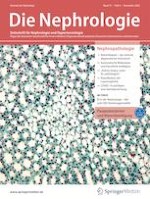Erschienen in:

10.11.2022 | Multiples Myelom | CME
Paraproteinämien und Nierenbeteiligung
verfasst von:
Prof. Dr. med. Harald Rupprecht, Prof. Dr. med. Kerstin Amann
Erschienen in:
Die Nephrologie
|
Ausgabe 6/2022
Einloggen, um Zugang zu erhalten
Zusammenfassung
Eine Nierenbeteiligung bei monoklonalen Paraproteinämien ist häufig. Die Cast-Nephropathie ist eine Erkrankung, die nur bei manifestem Myelom mit hoher Tumorlast auftritt. Dem gegenüber ist die monoklonale Gammopathie renaler Signifikanz (MGRS) definiert als Nierenbeteiligung, verursacht durch einen nephrotoxischen Klon, der per se aus hämatologischer Sicht nicht therapiebedürftig wäre. Die Diagnose einer MGRS kann nur mittels Nierenbiopsie gestellt werden. Hier kann der Nachweis von monotypischen Immunglobulin(Ig)-Ablagerungen entweder in organisierter (Amyloidose, fibrilläre Glomerulonephritis [GN], immunotaktoide GN, kryoglobulinämische GN) oder nichtorganisierter Form (monoklonale Ig-Ablagerungs-Erkrankung, proliferative GN mit monoklonalen Ig-Ablagerungen) erfolgen. 2 Formen einer MGRS können ohne Ig-Ablagerungen vorkommen, nämlich die C3-Glomerulopathie und die thrombotische Mikroangiopathie. Bei der Cast-Nephropathie besteht grundsätzlich eine Indikation zur Chemotherapie. Die Daten zur maschinellen Elimination von Leichtketten mittels Plasmapherese oder High-Cut-off-Dialyse sind widersprüchlich. Bei den Formen der MGRS muss anhand der renalen Prognose in Zusammenarbeit zwischen Nephrologen und Hämatologen die Therapieindikation gestellt werden. Nur eine klongerichtete Therapie kann hier zur Verbesserung der Nierenfunktion beitragen.